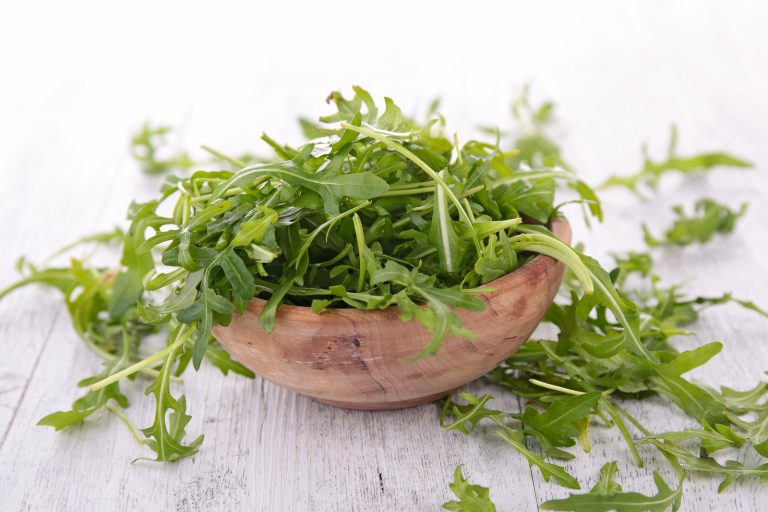Arugula is the spicy, peppery little leaf with the funny name. Some say it tastes bitter, others describe the flavor as ‘earthy’. However you describe its taste, this little leaf – with its intense green and its dandelion-leaf shape – is a powerhouse of nutrition.

Also known as Salad Rocket, the leaf pairs nicely with podded or snap peas, apple or pear wedges, roasted beets, and feta or goat cheese. You can even dress it up with toasted mushrooms and/or pistachio nuts, sprinkle with Parmesan, and top with balsamic vinaigrette or vinegar and olive oil. The oil is not only a dressing, but neutralizes the peppery bite of the arugula.
Arugula; the name comes to us from Greece (roka) via France (roquette) and, finally, England. But it’s much more fun to say it as the ancient Romans did, ‘ar-uu-gu-la’ (even if they did spell it somewhat differently, as Arugola).
Whatever you call it, arugula (with or without the initial capital letter) is not only a very timeless vegetable, but has some interesting – and unsuspected – characteristics. It is low-calorie and flavorful, as well as a great source of vitamins A, C and K. The first, from sunshine, is often sadly lacking in people who live in northern regions. The second, the so-called ‘sunshine vitamin’, is essential to skin, the heart, and stamina. In fact, this vitamin is so important to health that people who spend their days indoors, hunched over computers, can develop all sorts of ailments.
As for vitamin K, which is also abundantly present in arugula, medical professionals now think that this newly discovered supplement may be the “new vitamin D”. K is known to play a role not only in blood clotting and longevity, but also in heart disease, osteoporosis, cancer prevention, even dementia. Vitamin K is available by prescription only – or more readily in leafy green vegetables, especially arugula.
Even if you have trouble saying the word, you can savor its unique flavor by visiting regional farms or farmer’s markets and selecting the small, vividly green leaf with the strange name.
If, having once purchased some, you find yourself reluctant to eat it plain, try one of the recipes on Fill Your Plate. Or invent your own salad, pairing ingredients listed at the beginning of this article with some of your personal favorites. Arugula – the spiciest member of the same ‘family’ as kale, mustard greens, and cauliflower – goes well with almost anything, adding an aromatic, tangy (but not overpowering) flavor.
Arugula is a summer cooler, thanks to the same peppery flavor contained in mild to moderately hot peppers. It is also high in trace minerals like iron and copper. However, the one unexpected benefit – and the one that surprises people the most – is its reputation as an aphrodisiac!
Yes, arugula leaves and seeds are a love potion. The ancient Romans, who first added the seeds to olive oil as a flavoring, soon discovered that those who used the oil and ate the leaves had more stamina in the bedroom.
The Romans are gone, but arugula’s reputation remains. In fact, some cultures around the world combine it with lavender, rose, and chicory to enhance its romantic effect.
If you just want it for its nutrition, don’t forget you can also add it to sandwiches, Panini’s, burritos, and pitas for its lively flavor. Put a few shredded leaves into a cream-based soup, or make your own salsa or pesto, and watch your friends and family “rave the flav”!
Related articles
- Little Known Facts about Arizona’s Leafy Greens (fillyourplate.org)
- 8 Ways to Eat Healthy, Arizona Style (fillyourplate.org)
- Fun Facts about Salad (fillyourplate.org)

